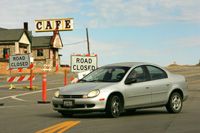Anatomy of a Road Rage Incident
A typical road rage incident happens when at least one driver chooses to act out in anger. Usually, the driver is already feeling stress when something triggers an aggressive reaction. Many road-rage drivers reported being under duress in other areas of their lives, like work or relationships, all of which contribute to a driver's stress level, making him more vulnerable to engaging in irrational behavior.
Dr. James also identifies several aspects of driving that contribute to our frustration and stress levels, including:
Advertisement
- Immobility - we're stuck sitting behind the steering wheel and can't physically relieve tension.
- Constriction - because we must drive on roads, our options are limited, often giving us the feeling of being boxed in.
- Lack of control - although we maintain control of our own vehicle, many other variables like traffic, lane closures, and the behavior of other drivers, are completely outside of our influence.
- Territoriality - like many animals, human beings react negatively when we feel our space is threatened by someone else.
- Denial and loss of objectivity - we tend to overlook our own faults and place blame on others.
- Unpredictability - we all know that every time we drive there are going to be unexpected events, such as someone pulling out into traffic ahead of you without warning -- this makes driving more stressful.
- Ambiguity - because there's no culturally agreed-upon way to signal an apology to another driver, it's easy to misinterpret someone's actions as a sign of aggression or insult.
[source: Dr. Driving.org]
Many police incident reports mention that multiple parties contributed to the escalation of emotions leading up to a violent encounter. As one driver reacts in anger to the other, the second driver in turn reacts negatively, and the emotions (and aggressive tactics) escalate, feeding each other in a vicious cycle. Ultimately, these behaviors lead to a complete surrender to base emotional reactions, and the drivers leave rationality behind.
Dan Goleman, a psychologist who coined the term Emotional Intelligence, says that anger is a seductive emotion. When you get angry, your heart beats faster and your body prepares for confrontation. The rush of adrenaline that comes as a result of real or perceived danger makes it easy for us to give into anger. It's a real challenge to impose self-control and behave in a way that's contradictory to how you initially feel. In other words, road rage tends to happen because it's easy to fall into the trap of directing anger toward another driver.
In the next section, we'll look at the sort of behaviors and tactics commonly associated with road rage.
